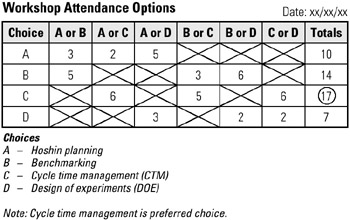Tool 128: Paired Comparison
| AKA | Comparison Grid |
| Classification | Evaluating/Selecting (ES) |
Tool description
The paired comparison tool requires all team participants to make choices on several pairs of items (options) such as problems, potential solutions, or activities, in order to arrive at a team decision. In other words, team participants can vote their individual preference, which, when totaled with the other participants' votes, will produce a team ranking of listed items.
Typical application
-
To quantify team participants' preferred items (choices) for the purpose of arriving at team consensus.
-
To force a team to consider the advantages and disadvantages of all listed options, to make comparisons, and to determine the most preferred choice among all options.
-
To prioritize a list of problems, potential solutions, or action items
Problem-solving phase
| → | Select and define problem or opportunity |
| Identify and analyze causes or potential change | |
| → | Develop and plan possible solutions or change |
| Implement and evaluate solution or change | |
| Measure and report solution or change results | |
| Recognize and reward team efforts |
Typically used by
| Research/statistics | |
| Creativity/innovation | |
| Engineering | |
| 2 | Project management |
| Manufacturing | |
| Marketing/sales | |
| Administration/documentation | |
| Servicing/support | |
| 3 | Customer/quality metrics |
| 1 | Change management |
before
-
Weighted Voting
-
Consensus Decision Making
-
Phillips 66
-
Criteria Filtering
-
Countermeasures Matrix
after
-
Project Planning Log
-
Action and Effect Diagram (AED)
-
What-If Analysis
-
Cost-Benefit Analysis
-
Action Plan
Notes and key points
-
Compare six or fewer items (options) since the number of comparisons increase significantly with the increase of items.
This can be calculated by:

# of items
# of comparisons
2
1
3
3
4
6
5
10
6
15
7
21
8
28
9
36
10
45
Step-by-step procedure
-
STEP 1 The team decides to attend a workshop of some quality-related topic. The team's eight participants have choices of Hoshin planning, benchmarking, cycle time management (CTM), and design of experiments (DOE). See example Workshop Attendance Options
-
STEP 2 A paired comparison grid is drawn on a flip chart. The four training choices are listed in column Choice as in the example shown.
-
STEP 3 Each participant considers every pair of choices and decides which is the preferred choice. One participant tracks the votes as all choices are voted on by all participants. The total votes for each comparison must equal eight, since every participant receives only one vote and no participant is allowed to pass!
-
STEP 4 Upon completion of voting on choices, and once all votes are recorded, the numbers in the pair columns are totaled. The highest number (total) in the totals column reflect the team's preferred choice of training.
Note The team's decision (total score = 17) calls for cycle time management (CTM) workshop attendance.
-
STEP 5 Date the final chart.
Example of tool application

EAN: 2147483647
Pages: 326